英语词汇学教程课件第10章English Lexicology 10上
- 格式:ppt
- 大小:518.00 KB
- 文档页数:20

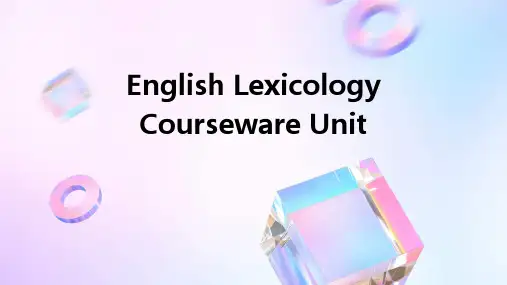
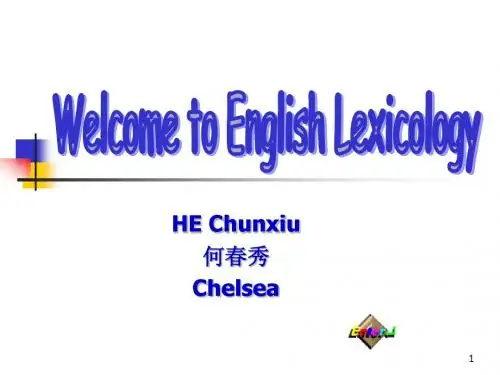
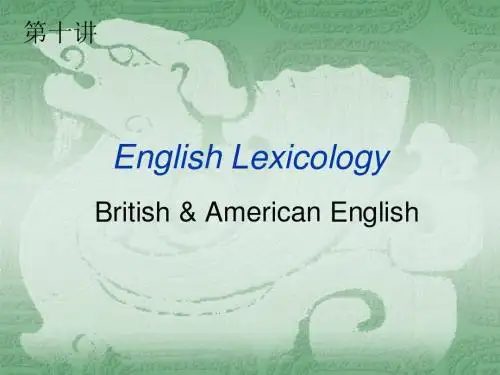
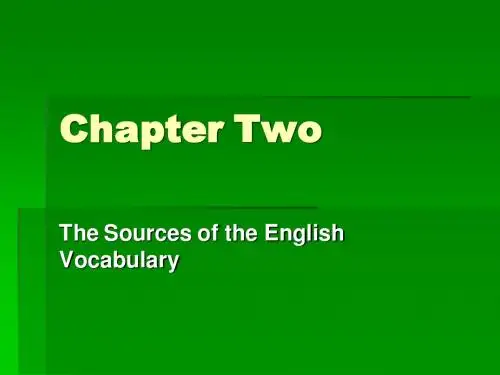
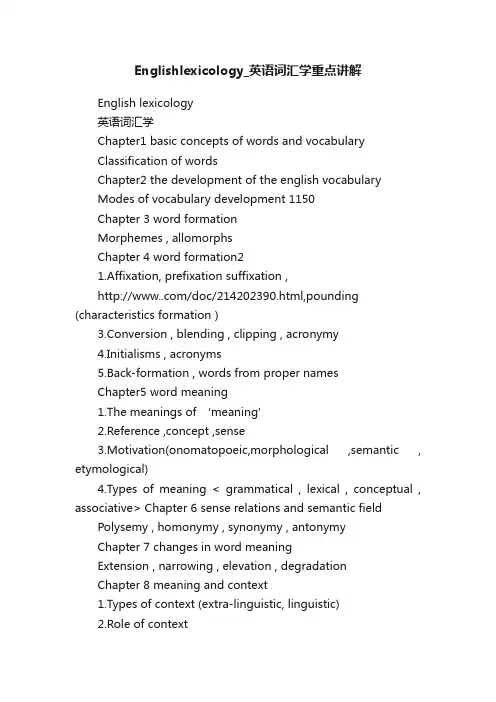
Englishlexicology_英语词汇学重点讲解English lexicology英语词汇学Chapter1 basic concepts of words and vocabularyClassification of wordsChapter2 the development of the english vocabularyModes of vocabulary development 1150Chapter 3 word formationMorphemes , allomorphsChapter 4 word formation21.Affixation, prefixation suffixation ,/doc/214202390.html,pounding (characteristics formation )3.Conversion , blending , clipping , acronymy4.Initialisms , acronyms5.Back-formation , words from proper namesChapter5 word meaning1.The meanings of ‘meaning’2.Reference ,concept ,sense3.Motivation(onomatopoeic,morphological ,semantic , etymological)4.Types of meaning < grammatical , lexical , conceptual , associative> Chapter 6 sense relations and semantic field Polysemy , homonymy , synonymy , antonymyChapter 7 changes in word meaningExtension , narrowing , elevation , degradationChapter 8 meaning and context1.Types of context (extra-linguistic, linguistic)2.Role of contexta.elimination of ambiguityb.indication of referencec.Provision of clues for inferring word-meaningChapter9 english idioms1.Classification of idioms(nominal , adjectival , verbal , adverbial )2.sentence and useChapter 10 english DictionariesTypes of dictionary , three good Dictionarya.Longman dictionary of contemporaryb.Collins COBUILD english Dictionaryc. A Chinese-english DictionaryUnit 1Methods of study ,there are generally two approaches to the study of words ,namely synchronic and diachronicAims and significance of the courseLanguage study involves the study of speech sounds ,grammar and vocabulary .vocabulary has proved particularly important and certainly the most difficult .Willkins asserts ‘without grammar very little can beconveyed ,without vocabulary nothing can be conveyed’ A good knowledge of morphological structure of english words and rules of word-formation will help learners develope their personal vocabulary and consciously increase their word power.V ocabularyAll the words in a language make up its vocabulary .The term vocabulary is used in different senses1.It can refers to the total number of the words in a language2.It can stands for all the words used in a particular historical period3.Also used to all the words of a given dialectClassification of wordsWords may fall into the basic word stock and nonbasic vocabulary by use frequency ,into content words and function words by notion ,and into native words and borrowed words by originBasic word stock have characteristics1.All national character2.Stability3.Productivity4.Polysemy5.Collocability6 Neutral in style7 Frequent in useWords void (lack)of the stated characters ,do not belong to the common core of the language ,they include the following: Terminology 术语,专有名词JargonSlang 俚语,黑话ArgotDialectal wordsArchaismsNeologismsContent words(=notional words) and function words (=empty words) Native words and borrowed wordsApart from the characteristics mentioned of the basic word stock ,in contrast to borrowed words ,native words have two other features Neutral in styleFrequent in useBorrowing words :words taken over from foreign languagesare known as borrowed words and loan words or borrowings in simple terms Loan words under four classesDenizens 同化词Aliens 异化词Translation-loans 译借词Semantic-loans 借意词The Indo-European language familyWhich can be grouped into roughly 300 language families on the basis of similarities in their basic word stock and grammar ,theIndo-Europe is one of them .it is thought to be a highly inflected language They accordingly fall into eight principle groups ,which can be grouped into an Eastern set : Balto-slavic, Indo-Iranian, American and Albanian; a Western set; Celtic , Italic, Hellenic,GermanicA historical overview of the english vocabularyThe first people known to inhabit the land were CeltsThe second major language known in England was the Latin of the Roman Legions450- < old > -1150-(Middle)-1500- -NOWModes of vocabulary developmentWe can concluded that modern english vocabulary develops through three channels < > creation , semantic change , borrowing Creation refers to the formation of new words by using the existing materials namely roots ,affixes and other elementsSemantic change means an old form which takes on a new meaning to meet the new needBorrowing has palyed a vital role in the development ofvocabulary ,particularly in earlier timesMorphemes :minimal meaningful units are known as morphemes,in other words ,th e morphemes is ‘the smallest functioning unit in the composition of words ’Chapter 5Word meaningWords are but symbols , many of which have meaning only when they have acquired reference .1.reference is the relationship between language and the word .The reference a word to a thing outside the language is arbitrary <随意的>and conventional <传统的>2.Concept<概念>=notionIn many cases meaning is used in the sense of ‘concept ’meaning and concept are closely connected but not identical3.Sense :generally speaking ,the meaning of ‘meaning’is perhaps what is termed ‘sense’ . ‘sense’denotes the relationships inside the language.Motivation <理据>Motivation accounts for the connection between the linguistic symbol and its meaningOnomatopoeic motivation 拟声的理据Morphological motivation 形态的理据Semantic motivation 语义<联想>的理据Semantic motivation refers to the mental associations suggested by the conceptual meaning of a wordEtymological motivation 词源的理据The meaning if many words often related directly to their origins, Types of meaninga.Grammatical meaning an Lexical meaning语法和词汇意义b.Conceptual meaning and associative meaning 概念和联想意义Chapter 6The subjects that have long held the interest and attention ofsemanticists are ,polysemy 多义的, homonymy , synonymy , antonymy , and hyponymyTwo approaches to polysemyDiachronic approach and synchronic approachThe meanings were acquired by extension ,narrowing ,analogy ,transfer The development of word-meaning from monosemy to polysemy follows two courses,traditionally known as radiation and concatenation HomonymyBased on the degree of similarity ,homonyms fall into three classes:perfect homonyms ,homographs and homophones1.Perfect homonyms are words identical both in sound and spelling but different meaning .Bank n. The edge of the river ,lakeBank n . An establishment for money businessBear n. A large heavy animalBear v. To put up withDate n. A kind of fruitDate n. A boy or a girl friend2.Homographs are words identical only in spelling but different in sound and meaningBow n. Bending the head as a greetingBow n. The device used for shooting arrowsSow v. To scatter seedsSow n. Female adult pig3.Homophones are words identical only in sound butdifferent in spelling and meaningDear n. A loved personDeer n.a kind of animalRight a. correctWrite v.to put down on paper with a penRite n. Ceremonial procedureSon n. A male child of someoneSun n. The heavenly body from which the earth gets warmth and light Of three types ,homophones constitute the largest number and are most commonOrigins of homonymsChange in sound and spellingBorrowingShortingAs homonyms are identical in sound or spelling ,particularly homophones, they are often employed to create puns<双关>for desired effect of ,say, humor,sarcasm or ridicule<嘲弄> On Sunday they pray for you and on Monday they prey <折磨>on you So-called pious<虔诚的>gentleman and ladies 善男信女The sardonic tone is unmistakable 讽刺的语气是不言而喻的SynonymySynonymy is one of the characteristic features of vocabulary of natural languagesTypes of synonyms1. Absolute synonyms also known as complete synonyms are words which are identical in meaning in all its aspects,both in grammatical meaning and lexical meaning ,including conceptual and associative meanings2. Relative synonymy also called near-synonyms are similaror nearly the same in denotation,but embrace different shades of meaning or different degrees of given quality.For example .to change a thing is to put another thing in its place ;to altera thing is to alter it in different manner and at different times .’A man change his habits ,alters his conduct ,and varies his manner of speaking’Look at stagger /reel/totter.stagger implies unsteady movement characters by a loss of balance and failure to maintain a fixed course . Stagger under a heavy load ;reel suggests a swaying or lurching so as to appear on the verge of falling .Silent沉默的,无言的,寂静的/ tacit , shine闪耀,发光/ glitter 华丽夺目,炫耀/sparkle闪耀,活跃,焕发活力和才智/glare强光,瞪眼,炫耀, different/ various, idle空闲的,懒惰的,无意义的/lazy/indolent , strange奇怪的/odd 古怪的/ queer,古怪的,可疑的large / huge庞大的/tremendous极大的,巨大的,惊人的,极好的/colossal Sources of synonyms1.BorrowingAs a result of the borrowing ,words of native origin form many couplets and triplets with those from other language2.Dialects and regional english3.Figurative an euphemistic4.Coincidence with idiomatic expressionsDiscrimination of synonymsThe differences between synonyms boil down to three areas: denotation , connotation ,and application1.Difference in denotation .‘I did not comprehend his arguments ,although i understood the language , and all the sentences’A lump of sugar一块糖, a slice of meat一片肉, a chunk ofwood , a sheet of paper A cake of soapTypes of antonyms1.Contradictory termsThe assertion of one is the denial of the otherAnother distinctive feature of this category <类型>is that such antonyms are non-gradable2.Contrary terms3.Relative termsHolds water <站得住脚的>Characters of antonyms1.Antonyms are classified on the basis of semantic opposition.words denoting nature, quality or state of things have many antonyms2.A word which has more than one meaning can have more than one antonym3.Antonyms differ in semantic inclusion .pairs of antonyms are seen as marked and unmarked terms respectively4.Contrary terms are gradable antonymsDestitute / opulent dull / livelyHyponymyHyponymy deals with the relationship of semantic inclusion.That is the meaning of more specific word word is included in that of another more general word .For instance ,tulip and rose are hyponyms of flowerSuperordinate termsHammer , saw , screwdriver ,spanner, plaice, cod , herring ,sole Semantic field <领域>The massive word store of a language like english an be conceived of as composed around a number of meaning areas.An integrated system of lexemes interrelated in sense 语义相互关联It is general belief that.....Personal address system 个人称呼KinshipTypes of changesWord-meaning changes by modes ofExtension< 扩展>,narrowing<缩小> ,degradation< 降格>,elevation< 升格>,and transferCauses of changes: it is in response to some needExtra-linguistic factors1.Historical reason2.Class reason3.Psychological 心理学的,精神上的reasonThe role of context <语境>1.Elimination of ambiguity <消除歧义>2.Indication of referents <限定所指>3.Provision of clues for inferring word -meaning <为猜测词义提供线索>①Definition②Explanation③Example④S ynonymy⑤Antonymy⑥Hyponymy⑦Relevant details⑧Word structureChapter 9Idioms consists of set phrases and short sentences ,which are peculiar to the language in question and loaded with the native cultures and ideas .therefore, idioms are colorful ,forcible andthought-provoking.For example ,fly off the handle (become excessively angry) and put up with ( tolerate)In a board sense ,idioms may included colloquialisms ,slang experience, proverbs .Character of Idioms1.Semantic unityBeing phases or sentences ,idioms each consist of more than one word ,but each is a semantic unity. Idiom have their respective literal meanings .for instance, till the cows come home Keep in mind take offto no avail like a breeze2.Structural stability 结构稳定First the constituents of idioms cannot be replacedLip service <support only="" in="" words="" ,not="" fact="" bdsfid="283"> is not to be changed into mouth service . Kick the bucket bury the hatchet。
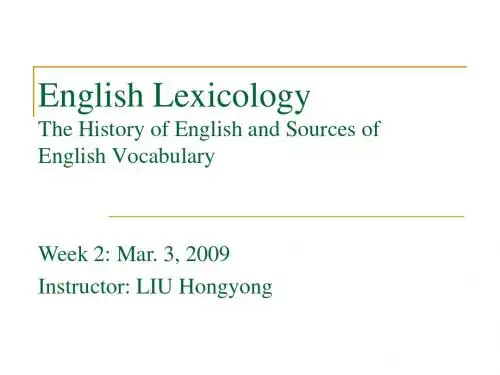
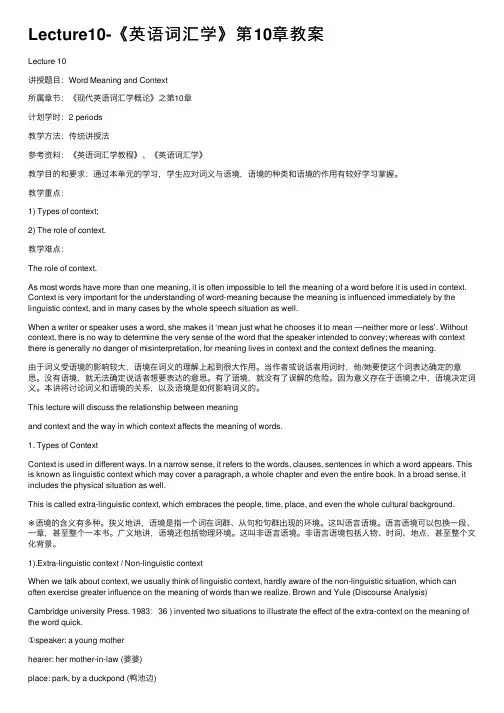
Lecture10-《英语词汇学》第10章教案Lecture 10讲授题⽬:Word Meaning and Context所属章节:《现代英语词汇学概论》之第10章计划学时:2 periods教学⽅法:传统讲授法参考资料:《英语词汇学教程》、《英语词汇学》教学⽬的和要求:通过本单元的学习,学⽣应对词义与语境,语境的种类和语境的作⽤有较好学习掌握。
教学重点:1) Types of context;2) The role of context.教学难点:The role of context.As most words have more than one meaning, it is often impossible to tell the meaning of a word before it is used in context. Context is very important for the understanding of word-meaning because the meaning is influenced immediately by the linguistic context, and in many cases by the whole speech situation as well.When a writer or speaker uses a word, she makes it ‘mean just what he chooses it to mean —neither more or less’. Without context, there is no way to determine the very sense of the word that the speaker intended to convey; whereas with context there is generally no danger of misinterpretation, for meaning lives in context and the context defines the meaning.由于词义受语境的影响较⼤,语境在词义的理解上起到很⼤作⽤。
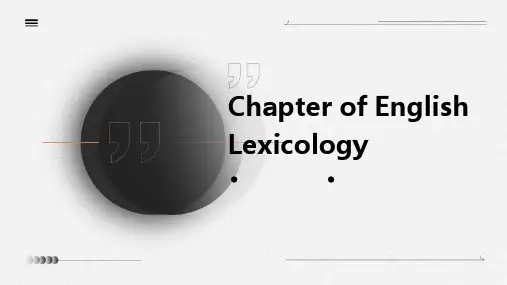
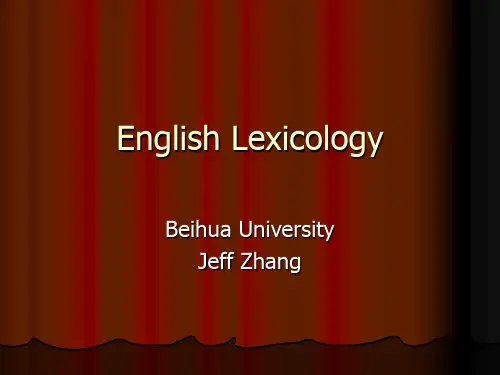
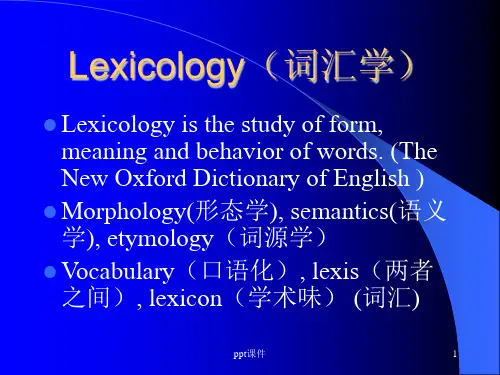
---------------------------------------------------------------最新资料推荐------------------------------------------------------ English Lexicology 英语词汇学简图Chapter 1 Basic Concepts 基本概念 1.1 the definition of a word (he definition of a word comprises the following points:(1) a minimal free form of a language; (2) a sound unity; (3)a unit of meaning; (4) a form that can function alone in a sentence. A word is a minimal free form of a language that has a given sound and meaning and syntactic function.) 1.2 sound and meaning :symbolic connection is almost always arbitrary and conventional. A dog is called a dog not because the sound and the three letters that make up the word just automatically suggest the animal in question. 1.3 sound and form : 1. 2. 3.4. No enough letters: alphabet from latin Pronunciation changed more rapidly Early scribes: change spelling for easier recognition Borrowing: different rules of pronunciation and spelling all national character 全民性stability 稳定性productivity 多产性 polysemy 一词多义 collocability 搭配性terminology 术语jargon 行话slang 俚语argon 黑话dialectal words 方言词 archaism 古语词 neologism 新词 1.4 vocabulary 1.5 classification of words 词汇分类by use frequency 按使用频率分:basic word stock and nonbasic vocabulary 基本词汇和非基本词汇basic word stock 基本词汇1/ 28obvious characteristics 明显的特点nonbasic vocabulary 非基本词汇by notion 按概念分: content words and functional words 实义词和功能词 native words 本地词 borrowed words 外来词neutral in style文体上中性by origin 按起源分: native words and borrowed words 本地词和外来词frequent in use 使用频繁denizens 同化词aliens 异形词translation-loans 译借词semantic-loans 借义词---------------------------------------------------------------最新资料推荐------------------------------------------------------ Chapter 2 DevelopmentIt is assumed that the world has approximately 3, 000 (some put it 5, 000 ) languages, which can be grouped into roughly 300 language families on the basis of similarities in their basic word stock and grammar. Prussian 普鲁士语 Lithuanian 立陶宛语 Polish 波兰语 Czech 捷克语Bulgarian 保加利亚语 Slovenian 斯洛文尼亚语 Russian 俄语Persian 波斯语 Bengali 孟加拉国语 Hindi 印地语 Romany 普吉赛语Balto-Slavic波罗的海-斯拉夫语Eastern set:东部诸语族:Indo-Iranian印度-伊朗语Armenian 2.1 Indo-European 印欧语亚美尼亚语Albanian 阿尔巴尼亚语 Celtic 凯尔特语Italic Western set:西部诸语族:意大利语Scottish 苏格兰语 Irish 爱尔兰语Welsh 威尔士语Breton 布里多尼语Portuguese 葡萄牙语Spanish 西班牙语 French 法语 Italian 意大利语 Roumanian 罗马尼亚语 Norwegian 挪威语 Icelandic 冰岛语 Danish 丹麦语Swedish 瑞典语 German 德语 Dutch 荷兰语 Flemish 佛兰德语English 英语Latin 拉丁语言Hellenic 希腊语——GreekGermanic日耳曼语Scandinavian languages 斯堪的纳维亚语3/ 28Old English (450--1150) —— Anglo-Saxon 古英语盎格鲁-撒克逊语50000-60000 words 5万~6万间词汇 Highly inflected 高度转折 complex endings 复杂的结尾 vowel changes 元音变化 2.2 Historical review 历史概述Middle English (1150-1500) 中古英语French words 法语词汇leveled endings 水平结尾Early Modern English (1500-1700) 早期现代英语Modern English (1500-up to now) 现代英语Borrow 借词new words 新词no endings 无结尾Late Modern English (1700-up to the present) 晚期现代英语 from a synthetic language (Old English) to the present analytic language。